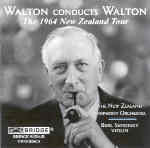Here’s a historical document of the first importance, preserved in very good sound and capturing William Walton as conductor at or near the top of his form. The New Zealand Symphony Orchestra of 1964 was more like a large chamber orchestra, with a comparatively small string section, but it plays with 100 percent commitment and certainly isn’t outclassed in the First Symphony and Partita by the Philharmonia in the composer’s commercial recordings for EMI. The opening Toccata of the latter work in particular goes like the wind, unlike Walton’s dull studio effort, and if the finale is a bit of a scramble, it’s certainly no worse than the stuff most English orchestras of the 1950s and early ’60s might have turned out on a given occasion in music of reasonable difficulty.
Not everything is perfect: timpani are mushy and poorly captured in the symphony, and the percussion in the finale’s coda sounds, well, strange (but again not worse than the “trash can lid” tam-tam on EMI); but I prefer Berl Senofsky’s warm and vibrant work in the Violin Concerto to Menuhin’s (Heifetz, of course, is another story altogether). The inclusion of God Save the Queen adds a touch of ceremony to the proceedings, and the two excerpts from Henry V (The Death of Falstaff and Touch Her Soft Lips and Part) make attractive encores.
As suggested above, the mono sonics are generally clear as a bell–and the audience is well behaved–making this essential for Waltonians, especially those dissatisfied with the composer’s EMI recordings. Interpretively there aren’t any special revelations–just good, lively music making and a palpable sense of occasion, which is exactly what this sort of archival production should be. And isn’t it nice to know that New Zealand had reason to be culturally proud well before Kiri Te Kanawa and Lord of the Rings?
































